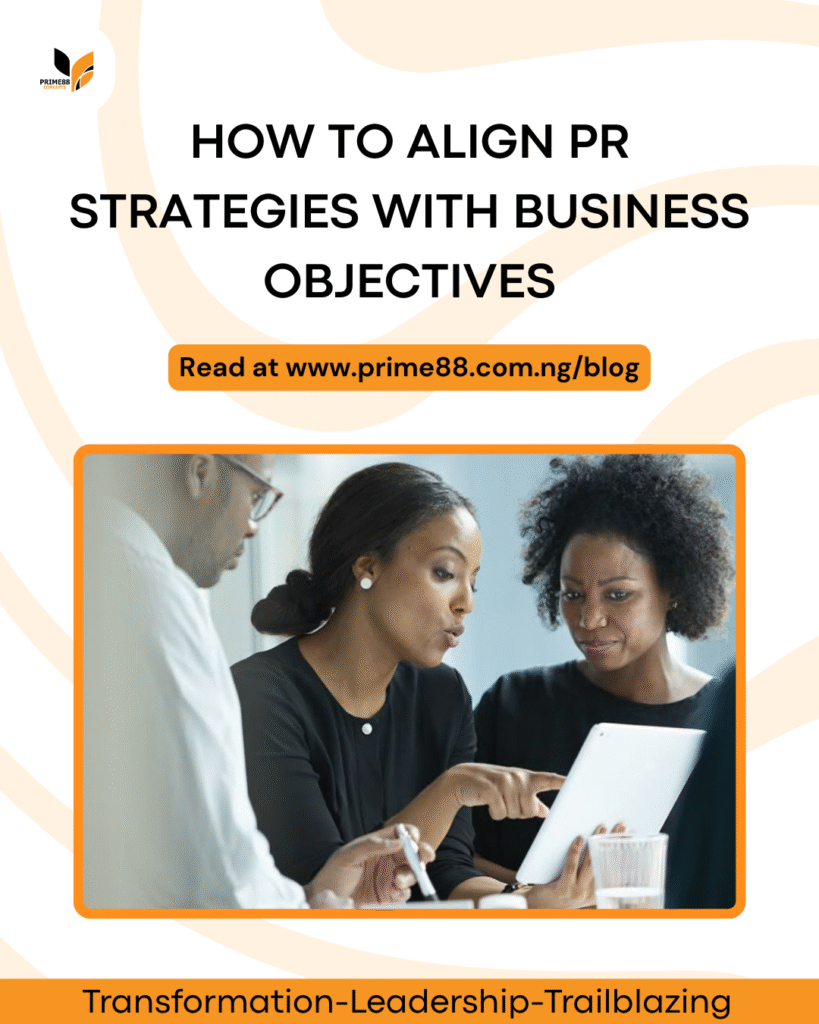
Aligning PR strategies with business objectives is essential for any company looking to convert visibility into measurable impact. Too many businesses regard public relations as an afterthought or a stand-alone effort limited to press releases or media coverage. What’s the truth? PR must be intimately linked into your main business objectives, from building brand trust to boosting revenue, expanding market share, strengthening stakeholder interactions, and establishing sustainability.
In this article, we dive into how to align PR strategies so it directly supports your business objectives. You’ll discover how defining goals up front, understanding your audience, crafting goal-driven messaging, choosing the right channels, and tracking outcomes can transform PR from a soft tool into a strategic engine for growth.
1. Understand Your Business Goals First
Everything starts with clarity. To establish a successful PR strategy, you must first grasp your company’s direction. Plan out your key business objectives and establish the performance measures, such as revenue, media sentiment, client acquisition, customer loyalty, stakeholder trust, and internal morale.
For example, if your company’s goal is to recruit investors, your Public Relations Strategies should focus on credibility by highlighting milestones, customer successes, leadership opinion pieces, and so on. If you want to acquire customers, you should concentrate on raising awareness and presenting your products’ stories.
Start here first. Every effective PR campaign begins with a deep understanding of business intent because when PR is grounded in business strategy, it stops being a marketing cost and becomes a strategic investment.
2. Define Clear PR Objectives That Support Your Business Goals
Once you know the high-level business goals, translate them into PR objectives that help you achieve them. Instead of “get press coverage”, aim for tangible PR outcomes like:
- Increasing share of voice in industry media among relevant audiences
- Driving qualified leads via thought leadership placements
- Growing visibility around corporate values or internal initiatives
This emphasizes linking PR goals to desired business impact; whether thought leadership, brand positioning, or engagement with target audiences. They’re part of a strategic framework where every PR effort supports one or more critical business priorities.
3. Know Your Audience
The most effective PR strategies are audience-led. Understanding who you want to reach; customers, investors, employees, regulators, community stakeholders shapes your tone, content, timing, and channels.
- Know their pain points.
- Understand where they spend time (media channels, social media platforms, events).
- Figure out what kind of messaging resonates with them.
For instance, if you’re launching a health tech product, targeting a tech-savvy audience through platforms like Techpoint Africa or Nairametrics might make more sense than generic news coverage.
Understanding your audience is what makes your message relevant. And relevance is key to both PR success and achieving business goals.
4. Craft Messaging That Reflects Your Goals
With goals and audiences established, your communications must convey value, purpose, and influence. Your narrative should be consistent across media, yet personalized to each audience segment. If your company’s goal is to lead in sustainable innovation, your marketing should emphasize local sourcing, community benefits, or environmental responsibility.
If you want to gain public trust, focus your messaging on transparency, customer stories, and results. Use credible storytelling to drive a message because when messaging reflects business goals, PR becomes authentic, purposeful, and persuasive.
5. Choose the Right PR Channels
Not every channel moves the needle equally. Media relations, social platforms, events, influencer partnerships, podcasts, or trade journals all serve different purposes. Choose the right PR channels based on where your key audiences engage and which channels best deliver measurable outcomes.
Start by asking:
- What platforms do our target customers or stakeholders trust?
- Which blogs, newspapers, podcasts, or influencers do they follow?
For instance, to build credibility among industry peers, expert commentary in respected financial or sustainability outlets might be the most effective; to reach younger urban consumers, influencer-led social campaigns could be more impactful.
Also, don’t overlook owned channels like your blog, email newsletters, or social media. When these are used effectively, they allow you to control the narrative and reach your audience directly.
Every channel you use should serve a clear purpose in helping you achieve your PR and business goals.
6. Measure the Results and Adjust
Once your campaign is live, don’t just sit back and hope it works. You need to measure the outcome of every effort.
Some key PR metrics include:
- Media mentions
- Website traffic from earned media
- Social media engagement
- Brand sentiment
- Number of inbound leads
- Search engine visibility
Use tools like Google Analytics, social media insights, and media monitoring platforms to track what’s working and what’s not. If something isn’t performing well, don’t panic. Tweak your messaging. Try new platforms. Refine your media list.
PR should not be a one-time shot. It’s an evolving part of your business that should grow and adapt as your business goals shift.
Conclusion
When PR strategies are built on a foundation of business goals, clear objectives, audience insight, purposeful messaging, and channel precision, they evolve into strategic revenue. You transform visibility into value and narratives into measurable outcomes. PR stops being noise and becomes your voice in action: compelling, credible, and aligned with business purpose.
So I leave you with this question:
Is your PR strategy helping you achieve your business goals or just chasing headlines?
At Prime88 Concepts, we understand that aligning PR strategies with business objectives is essential. That’s why we help brands create intentional, results-driven PR strategies that reflect their mission and long-term goals. From defining clear messaging to selecting the right communication channels, we work with businesses to ensure every PR effort supports their business goals.


